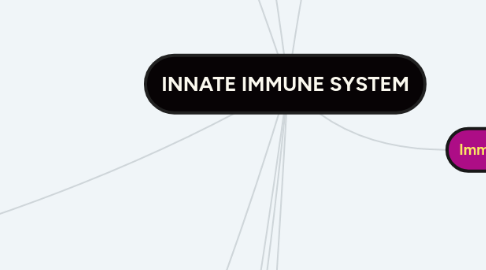
1. C3a,C4a & C5a cause degranulation of mast cells with release mediators, leading to increased vascular permeability and smooth muscle contraction
2. Clinical aspects of complement
2.1. Red cell hemolysis
2.2. Acute glomerulonephritis and systemic lupus erythematosus (SLE)
3. Classification of cytokines
3.1. Interleukins: cytokines made by one leukocytes and acting on other leukocytes
3.2. Chemokines: cytokines with chemotactic activities
3.3. Interferons: tissue antiviral cytokines
3.4. Transforming growth factors: growth, stimulation
3.5. Tumor necrosis factors: induction of apoptosis
4. Role:phagocytosis,eliminate intracellular bacteria,virus infected&cancerous cells, antigen presentation to T lymphocytes, release proteins to attract other cells(chemokines) and activate other immune cells(cytokines)
5. Mechanism
5.1. 1)Phagocytes(myeloid cells)
5.1.1. Example:
5.1.1.1. 1)Macrophage
5.1.1.2. contains purple-black granules rich in histamine&heparin
5.1.1.3. 2)Neutrophils
5.1.1.4. 3)Dendritic cells
5.1.1.5. 3)Attachment of foreign particle to phagocyte.
5.1.1.6. 4)Monocytes
5.1.1.6.1. Roles: Act as antigen presenting cells(APC), specialized for uptake&presentation of antigen for activation of T lymphocytes. take up antigen by phagocytosis,receptor mediated endocytosisµpinocytosis, pick up antigen from periphery of the blood&deliver it to lymphoid organs where it presents the processed antigen T cells
5.2. Phagocytosis?
5.2.1. Process of engulfment&destruction of solid particles such as bacteria,dead tissue&foreign particles by cells.
5.2.2. Stages:
5.2.2.1. 1)Detection&Opsonization of foreign particle&movement of the phagocyte to the area.
5.2.2.2. 3)Engulfment/ingestion of foreign particle into a vesicle called a phagosome.
5.2.2.3. 4)Fusion of phagosome with lysosome to form phagolysosome&acidification.
5.2.2.4. 5)Intracellular killing&digestion.
5.3. 2)Natural killer (NK )cells
5.3.1. non-phagocytic but direct kill of infected cells (cytoplasmic granule include molecules that enter the infected cells&activates enzyme that induce apoptotic death)
5.3.2. Don't require antigen stimulation
5.3.3. Roles:recognize&kill some abnormal cells with low MHC Class I
5.4. 3)Mast cells
6. Complement System
6.1. Complement?
6.1.1. a group of 30 serum proteins involved in activation "cascade"
6.1.2. Biologic effects:
6.1.2.1. 1)Opsonization
6.1.2.1.1. microbes (bacteria&viruses ate phagocytosed much better in the presence of C3b(receptor on phagocytes))
6.1.2.2. 2)Anaphylatoxin
6.1.2.3. 3)Chemotaxis
6.1.2.3.1. C5a and C5,6,7 complex attract neutrophils
6.1.2.4. 4)Cytolyisis
6.1.2.4.1. insertion of the C5b,6,7,8,9 membrane attack complex (MAC) into cell membrane forms a pore in the membrane results in killing(lysis) of many cell types
6.1.3. Complement cascade
6.1.3.1. step in which each protein component takes turn in a precise chain
6.1.3.1.1. end products are membrane attack complex (MAC)
6.1.3.2. MAC
6.1.3.2.1. inserted into cell walls that surround the invading bacteria causes cytolysis
6.1.3.3. 3 Pathways of Complement Activation
6.1.3.3.1. Classical pathway
6.1.3.3.2. Lectin pathway
6.1.3.3.3. Alternative pathway
6.1.3.4. Effect of complement activation
6.1.3.4.1. Partial:inflammation reaction and cell coating
6.1.3.4.2. Complete:bacterial lysis(cytolysis)
7. Cytokines
7.1. soluble proteins that mediate:
7.1.1. immune reactions
7.1.2. inflammatory reactions
7.1.3. communication between leukocytes: immune cells will secrete cytokines
7.2. Chemokines
7.2.1. immediate inflammation (cell recruitment)
7.3. Act in 3 ways
7.3.1. a) Autocrine
7.3.1.1. cytokine binds to receptor on cell that secreted it
7.3.2. b) Paracrine
7.3.2.1. cytokine binds to receptor on nearby cells
7.3.3. c) Endocrine
7.3.3.1. cytokine binds cells in distant parts of the body
7.4. Receptors for the various cytokines are quite diverse structurally
8. Immunity?
8.1. Ability of the body to fight infection and/or foreign invaders by producing antibodies/killing infected cells.
9. Immune System
9.1. A complex network of cells and proteins that defends the body against infection.
9.2. Innate(non-specific defences)
9.2.1. 1)First line
9.2.1.1. skin
9.2.1.2. mucous membrane
9.2.2. 2)Second line
9.2.2.1. phagocytic leukocytes
9.2.2.2. antimicrobial proteins
9.2.2.3. inflammatory response
9.2.2.4. fever
9.2.2.5. Functions:
9.2.2.5.1. a)To clean up debris from dying cells&repairing damage tissues
9.2.2.5.2. b)To kill invading microbes
9.2.2.5.3. c)To activate adaptive immune system
9.2.2.5.4. Specificity-limited(same response is mounted to a variety of phatogens)
9.2.3. Characteristics
9.2.3.1. Duration-short(days)
9.2.4. Memory-absent
9.3. Adaptive(specific defences)
9.3.1. 3)Third line
9.3.1.1. lymphocytes
9.3.1.2. antibodies
9.3.1.3. memory cells
9.3.2. Characteristics
9.3.2.1. Lag phase-present(response take at least few days)
9.3.2.2. Duration-long(months/year)
9.3.2.3. Specificity-high(response is directed only to the agents that initiated it)
9.3.2.4. Memory-present
